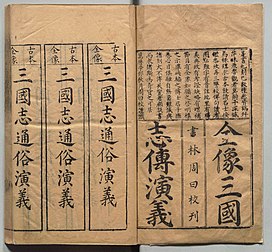
Back Roman van die drie koninkryke Afrikaans رومانسية الممالك الثلاث (رواية) Arabic Romance de los Trés Reinos AST Өс батшалыҡ (роман) Bashkir ༼རྒྱལ་ཁབ་གསུམ་གྱི་གཏམ་རྒྱུད།༽ Tibetan Romanç dels Tres Regnes Catalan Săng-guók Iēng-ngiê CDO ئەوینی سێ شانشینەکە CKB Příběhy Tří říší Czech Beretningen om de tre kongedømmer Danish
 Title pages from a 1591 printed edition of the novel | |
| Author | Luo Guanzhong |
|---|---|
| Original title | 三國演義 |
| Language | Chinese |
| Subject | Imperial China |
| Genre | Historical fiction |
| Set in | China, AD 169–280 |
Publication date | 14th century |
| Publication place | China |
Published in English | 1907 |
| Media type | |
| 895.1346 | |
Original text | 三國演義 at Chinese Wikisource |
| Translation | Romance of the Three Kingdoms at Wikisource |
| Romance of the Three Kingdoms | |||||||||||||||||||||||||||
|---|---|---|---|---|---|---|---|---|---|---|---|---|---|---|---|---|---|---|---|---|---|---|---|---|---|---|---|
| Chinese name | |||||||||||||||||||||||||||
| Traditional Chinese | 三國演義 | ||||||||||||||||||||||||||
| Simplified Chinese | 三国演义 | ||||||||||||||||||||||||||
| |||||||||||||||||||||||||||
Romance of the Three Kingdoms (traditional Chinese: 三國演義; simplified Chinese: 三国演义; pinyin: Sānguó Yǎnyì) is a 14th-century historical novel attributed to Luo Guanzhong. It is set in the turbulent years towards the end of the Han dynasty and the Three Kingdoms period in Chinese history, starting in 184 AD and ending with the reunification of the land in 280 by the Western Jin. The novel is based primarily on the Records of the Three Kingdoms, written by Chen Shou in the 3rd century.
The story – part historical and part fictional – romanticises and dramatises the lives of feudal lords and their retainers, who tried to supplant the dwindling Han dynasty or restore it. While the novel follows hundreds of characters, the focus is mainly on the three power blocs that emerged from the remnants of the Han dynasty, and would eventually form the three states of Cao Wei, Shu Han, and Eastern Wu. The novel deals with the plots, personal and military battles, intrigues, and struggles of these states to achieve dominance for almost 100 years.
Romance of the Three Kingdoms is acclaimed as one of the Four Great Classical Novels of Chinese literature; it has a total of 800,000 words and nearly a thousand dramatic characters (mostly historical) in 120 chapters.[1] The novel is among the most beloved works of literature in East Asia,[2] and its literary influence in the region has been compared to that of the works of Shakespeare on English literature.[3] It is arguably the most widely read historical novel in late imperial and modern China.[4] Herbert Giles stated that among the Chinese themselves, this is regarded as the greatest of all their novels.[5]
- ^ Roberts 1991, pg. 940
- ^ Kim, Hyung-eun (11 July 2008). "(Review) Historical China film lives up to expectations". Korea JoongAng Daily. Archived from the original on 25 December 2011.
The Romance of the Three Kingdoms is comparable to the Bible in East Asia. It's one of the most-read if not, the most-read classics in the region.
{{cite web}}: CS1 maint: unfit URL (link) - ^ Shoji, Kaori (6 November 2008). "War as wisdom and gore". The Japan Times. Archived from the original on 2 June 2021. Retrieved 8 May 2020.
In East Asia, Romance is on par with the works of Shakespeare... in the same way that people in Britain grow up studying Hamlet and Macbeth.
- ^ Ng, On-cho; Wang, Q. Edward (2005). Mirroring the Past: The Writing and Use of History in Imperial China. Honolulu: University of Hawaii Press. p. 86. ISBN 0824829131.
- ^ Herbert Giles (1901). A History of Chinese Literature. London: W. Heinemann. p. 277.
If a vote were taken among the people of China as to the greatest among their countless novels, the Story of the Three Kingdoms would indubitably come out first.